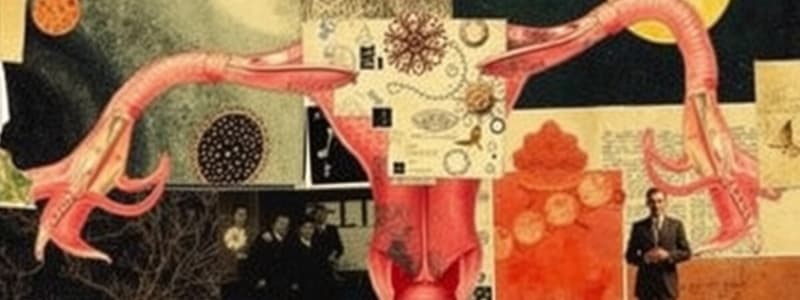Podcast
Questions and Answers
What does the female symbol represent in ancient mythology?
What does the female symbol represent in ancient mythology?
- A spear
- A mirror (correct)
- A shield
- A tree
The ovarian ligament is one of the ligaments associated with the male reproductive system.
The ovarian ligament is one of the ligaments associated with the male reproductive system.
False (B)
What structure is referred to as the organ where the male gamete meets the female gamete?
What structure is referred to as the organ where the male gamete meets the female gamete?
ampulla of the fallopian tube
The _____ connects the kidney to the urinary bladder.
The _____ connects the kidney to the urinary bladder.
Match the following parts of the male reproductive system with their functions:
Match the following parts of the male reproductive system with their functions:
Which part of the female reproductive system is responsible for the monthly shedding of the uterine lining?
Which part of the female reproductive system is responsible for the monthly shedding of the uterine lining?
The seminal vesicle joins with the vas deferens to form the ejaculatory duct.
The seminal vesicle joins with the vas deferens to form the ejaculatory duct.
What is the primary function of the fallopian tube?
What is the primary function of the fallopian tube?
The female reproductive organ that expands during childbirth is the _____ canal.
The female reproductive organ that expands during childbirth is the _____ canal.
What structure is referred to as the 'scrotal sac'?
What structure is referred to as the 'scrotal sac'?
What is the primary role of gonads in males and females?
What is the primary role of gonads in males and females?
Meiosis results in two identical daughter cells.
Meiosis results in two identical daughter cells.
What is the name of the process through which sperm is produced?
What is the name of the process through which sperm is produced?
The ovum is produced from the _____ during oogenesis.
The ovum is produced from the _____ during oogenesis.
Match the following terms related to meiosis to their definition:
Match the following terms related to meiosis to their definition:
Which of the following statements is true regarding the sperm and ovum?
Which of the following statements is true regarding the sperm and ovum?
Meiosis is also referred to as reduction division.
Meiosis is also referred to as reduction division.
Why is the process of oogenesis responsible for producing only one ovum?
Why is the process of oogenesis responsible for producing only one ovum?
The phenomenon of _____ contributes to genetic diversity during meiosis.
The phenomenon of _____ contributes to genetic diversity during meiosis.
What is the end result of spermatogenesis?
What is the end result of spermatogenesis?
Study Notes
Reproductive System Symbols
- The female symbol resembles a mirror, representing femininity rooted in ancient Greek and Roman mythology.
- The male symbol depicts armor and a spear, emphasizing strength and protection.
Female Reproductive System
- Right ovary plays a key role in egg production.
- Fimbriae of the fallopian tube help guide the egg into the tube.
- The fallopian tube is vital for fertilization; the widest area (ampulla) is where male and female gametes unite.
- The uterus is essential for pregnancy, with separate layers:
- Endometrium: inner lining, thickens for implantation.
- Myometrium: muscular layer aiding in contractions.
- Perimetrium: outer protective layer.
- Ovarian ligament connects ovaries to the uterus, supporting their position.
- Broad ligament provides additional support to reproductive organs.
- Cervix serves as a passage between the vagina and uterus, with two meanings (neck-like structure).
- Vaginal canal features a zigzag shape to increase surface area and accommodate childbirth.
Male Reproductive System
- Mnemonic "7UP" helps remember key structures:
- S: Seminiferous tubules.
- E: Epididymis.
- V: Vas deferens.
- E: Ejaculatory duct.
- U: Urethra.
- P: Penis.
- Scrotum houses the testicles, regulating temperature for sperm production.
- Seminiferous tubules produce sperm within the testicle.
- Epididymis stores mature sperm.
- Vas deferens serves as the duct transporting sperm to the ejaculatory duct.
- Urethra carries urine and sperm, differentiated into prostatic and penile sections.
- Penile structure includes the glans penis, which is sensitive and crucial for copulation.
Gametes and Gonads
- Gonads: ovaries (female) and testicles (male); produce gametes.
- Gametes: ovum (female) and sperm (male).
- Mitosis results in two identical daughter cells; meiosis results in four non-identical haploid cells.
Meiosis Overview
- Meiosis consists of two rounds of division leading to genetic diversity through crossover in prophase I.
- Begins with diploid cells (2n) and ends with haploid cells (n).
Spermatogenesis
- Process starts with spermatogonium, leading to primary spermatocyte, then two secondary spermatocytes, each producing two sperm.
- End result: four genetically diverse sperms, with half carrying X and half carrying Y chromosomes.
Oogenesis
- Oogenesis produces one ovum from one oogonium, with polar bodies resulting from meiotic divisions.
- The ovum retains most cytoplasm to nourish the future zygote, while sperm provides only nuclear material.
Fertilization
- Fertilization occurs when sperm meets the secondary oocyte, which is arrested at metaphase II, signaling the readiness for potential fertilization.
Studying That Suits You
Use AI to generate personalized quizzes and flashcards to suit your learning preferences.
Description
Explore the intriguing symbolism behind male and female symbols in the reproductive system. This quiz delves into the historical and mythological origins of these representations, shedding light on their significance. Understand how ancient mythology influences our contemporary understanding of gender representation.




